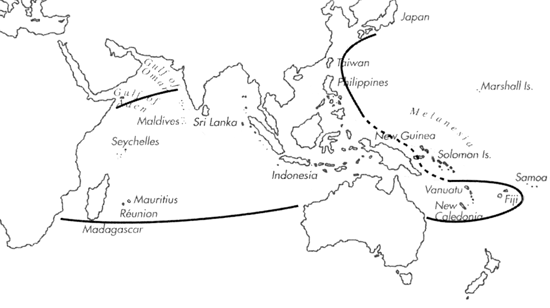Range: Indian Ocean: Natal to India and Indonesia (absent from the Red Sea); Pacific: Japan to the Philippines and Queensland to Fiji.
Description: Medium-sized to large, solid to heavy. Last whorl ventricosely conical to broadly ventricosely conical or slightly pyriform; outline convex adapically, straight or slightly concave towards base; left side consistently sigmoid. Shoulder rounded. Spire usually low, outline variably sigmoid or concave. Teleoconch sutural ramps flat to slightly convex, with many spiral striae. Last whorl with variably pronounced and spaced spiral grooves on basal third, separating ribs and ribbons.
| Shell Morphometry | ||
|---|---|---|
| L | 45-135 mm | |
| RW | 0.30-1.50 g/mm | |
| RD | 0.52-0.74 | |
| PMD | 0.74-0.84 | |
| RSH | 0.05-0.13 | |
Ground colour varies from yellowish or orangish cream through reddish to greyish or blackish brown. Last whorl with variably spaced, solid or occasionally dashed or dotted spiral lines of brown or black; lines usually absent from a narrow band below shoulder edge; subshoulder band may contrast in colour from adjacent area of last whorl, ranging from yellow to dark reddish brown. Teleoconch sutural ramps orange-brown to blackish brown, darker than last whorl; occasionally with variably broad, irregularly set radial streaks. Aperture white or bluish white.
Periostracum brown, of varying thickness, translucent to opaque, either uniformly rough or with raised spiral ridges.
Operculum ovate. Radular teeth with an adapical barb opposite to a blade; serration longer than blade (Peile, 1939).
Habitat and Habits: Intertidal and uppermost subtidal; in semi- sheltered or protected sites, living on fine to very fine sand of flats, often among vegetation (Kohn, 1960; Cernohorsky, 1964; Kilburn & Rippey, 1982; Grosch, pers. comm., 1989). C. figulinus probably feeds on polychaetes (Kohn, 1960; Endean & Rudkin, 1965). C. figulinus lives on soft substratum without suitable solid objects to affix its egg capsules, and it exhibits a special form of capsule clusters: About the first five capsules are empty and lack an exit window. They are buried in the substrate and serve as an anchor for the later capsules containing eggs. The capsules are attached to each other forming an irregularly branching cluster, becoming more randomly attached during oviposition. The surface of the capsules has a rather regular network of corrugations. Anchoring capsules measure 16-19x7-12 mm and vary in shape (19x7 to 17x12 mm). Definitive capsules measure 18- 19 x 11-13 mm and contain 5,700-8,600 eggs per capsule (Sri Lanka); from N. Queensland, larger capsules (25.5-29x10-17 mm) have been collected (AMS), with neighbouring capsules exhibiting confluent basal plates. In Sri Lanka, egg diameter is 190-210 fm, predicting a minimum pelagic period of about 23 days (Kohn, 1961a; Perron & Kohn, 1985).
Discussion: C. figulinus is most closely related to C. betulinus and C. loroisii. C. betulinus attains larger size and has a broader last whorl; the spiral rows on its last whorl contain intermittent white markings and its sutural ramps bear dark radial blotches. Some specimens of C. figulinus from Natal, Mozambique and Madagascar have dashed or dotted lines without the intermittent white markings and with irregular dark streaks on the sutural ramps. For specimens agreeing with the description of C. zulu, see the DISCUSSION of C. betulinus. For differences between C. figulinus and C. loroisii, see the DISCUSSION of the latter species.

C. figulinus range map
This section contains verbatim reproductions of the accounts of 316 species of Conus from the Indo-Pacific region, from Manual of the Living Conidae, by Röckel, Korn and Kohn (1995). They are reproduced with the kind permission of the present publisher, Conchbooks.
All plates and figures referred to in the text are also in Röckel, Korn & Kohn, 1995. Manual of the Living Conidae Vol. 1: Indo-Pacific Region.
The range maps have been modified so that each species account has it own map, rather than one map that showed the ranges of several species in the original work. This was necessary because each species account is on a separate page on the website and not confined to the order of accounts in the book.